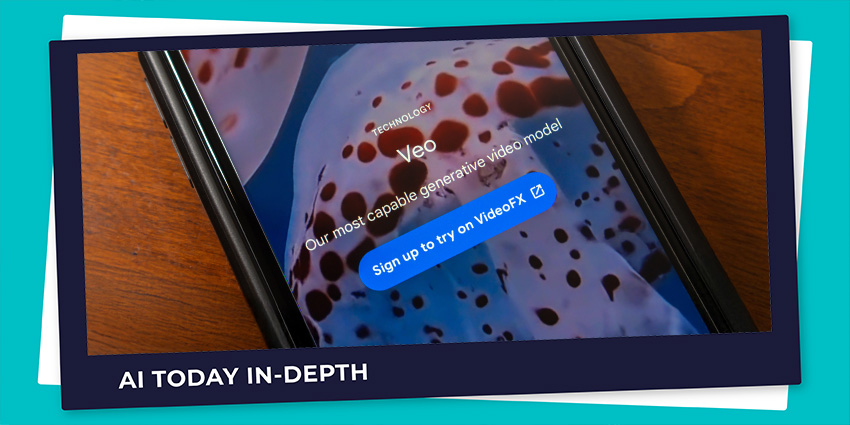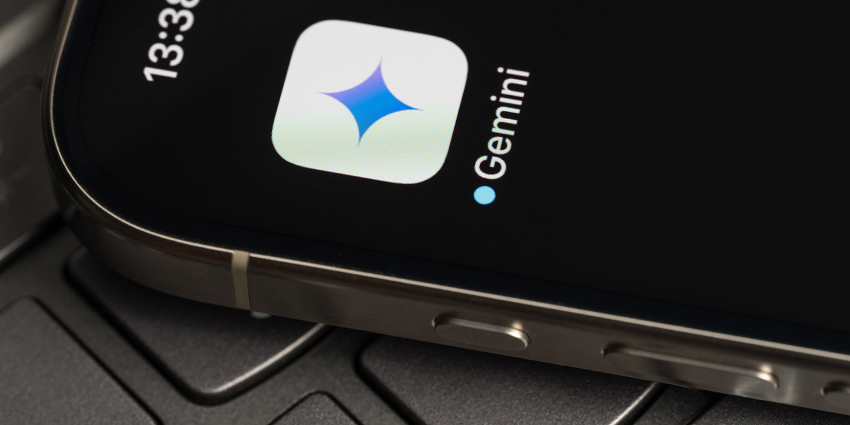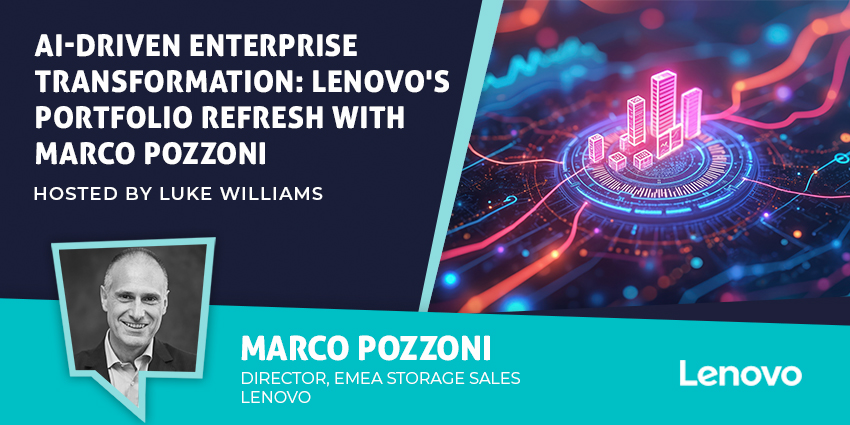Generative AI isn’t just a great tool for creating text-based content anymore. The era of multimedia AI content creation has arrived, empowering AI users to produce everything from audio to images and video. Google Veo is Google’s champion in the battle for video generation supremacy.
Announced just after OpenAI began generating hype for its “Sora” video generation platform, Veo is entering the market a little later than some if its competitors. Still, Google has already proven it has a knack for multimodal AI technology.
The company’s Imagen image creation models have quickly earned global popularity, and even Google Gemini (the multimodal assistant) is making waves in the enterprise space. So, what exactly can Google Veo do – what makes it special, and how do you start experimenting with it?
What Is Google Veo?
Google Veo is Google’s most “advanced” AI video generation model, initially introduced in May 2024, at Google I/O. It was announced alongside Imagen 3 – the latest image generation model from the cloud computing giant.
Notably, this isn’t the first time Google has experimented with video generation. The company has launched various tools in the last few years, such as Phenaki, Imagen Video, and even the Lumiere model showcased in January 2024. However, all of these initial options had a lot of limitations. They weren’t really designed to compete with ultra-realistic video generators, like OpenAI’s Sora.
Google says, with Veo, the company has fine-tuned various techniques that enhance how the model learns to “understand” what’s actually happening in a video, render high-definition images, and even simulate real-world physics. Based on user prompts, the new tool can generate 1080p videos at 24 to 30 FPS. So far, Google has shared some impressive examples of what the model can do.
The Deepmind website includes a few sample videos of videos generated with Veo, like one of a cowboy riding on a horse, or time-lapse of a sunflower opening. Plus, Google also shared an insight into their work with Donald Glover and the Gilga creative studio, who used Gilga for a film project.
What makes Veo unique, aside from it’s ability to better understand input, and create higher-quality visuals, it that it can also create “longer” videos than Google’s previous models. You can even create videos that go beyond a minute in length.
Plus, Veo can deliver unique “cinematic” results. It can understand terms in prompts like “aerial shot” or “time lapse”, giving users a lot more control over the final content.
What Can Google Veo Do? Why Veo is Different
Unlike other Google AI models (such as Gemini), Google Veo is specifically focused on one thing: creating videos. However, that doesn’t mean it’s not versatile. Veo can generate video content based on all kinds of prompts. For instance, you can enter a standard “text-based” prompt, just like you would with a tool like DALL-E, to create short video clips.
Alternatively, you can use images and text to ask Veo to create a video for you. For instance, you might give the model a picture of a dog and ask it to create a clip that features that puppy running around or playing with a ball.
Google says Veo has a comprehensive understanding of natural language and visual semantics that can capture the tone and nuance of all kinds of prompts. You can even ask the model to apply tweaks and specific cinematic effects, as mentioned above.
Plus, Veo goes beyond simple or “basic” animation sequences. Thanks to its understanding of natural physics, it can generate realistic movements for animals, objects, and people. Veo also works for editing existing video inputs.
For instance, a user could upload a video clip they’ve taken from a park and ask Veo to add flowers or a swing set. Once your footage is ready, you can swap out different elements, scenes, and components. That’s perfect if you’re trying to make quick adjustments to content.
Another key thing that sets Google Veo apart from other video generation tools is that it ensures high video consistency. If you’ve tried to create a clip with AI before, you might have noticed that the output sometimes introduces abrupt frame changes. However, Veo’s algorithms (diffusion transformers) smooth those out, keeping inconsistencies to a minimum for less jarring content.
How to Use Google’s Video Generation Tool on YouTube
Initially, when Google introduced Veo in Spring this year, it was only available through an “early access” phase, limited to a select group of testers on the VideoFX platform. You had to visit the “Test Kitchen” created by Google, and join a waitlist for a chance to try the tool.
However, throughout the year, Google has introduced Veo to more environments. In September, it announced a new Veo integration for YouTube’s short-form video format (YouTube Shorts), allowing creators to generate backgrounds and six-second video clips.
Google noted that this would be a significant upgrade from the AI-powered tools already available in YouTube (through Dream Screen). Dream Screen previously allowed creators to generate background using text prompts in Shorts too. However, Google believes Veo will further enhance the process, enabling creators to produce more impressive clips.
Veo also introduces the opportunity to create six-second-long standalone videos for YouTube Shorts. When creators enter a prompt in the “Create” section of the platform, Dream Screen will develop a series of four images, which can be used with Veo to create videos.
The new capability will even allow creators to add unique “filler scenes” to videos, enabling smoother transitions and tying stories together more effectively.
How to Use Google Veo in Vertex AI
After introducing some of Google Veo’s basic features to YouTube creators, Google made a new announcement in December 2024. Users will now be able to access Veo in private preview and Imagen 3 in Vertex AI, too. Vertex AI—for those unfamiliar with the platform—is Google’s orchestration platform that makes it easy for developers to customize, evaluate, and deploy AI models.
Within Vertex AI, users can use the features of the video generation model to create consistent, coherent video content that is suitable for a range of applications.
According to Google, companies like “Agoda” are already using AI models like Veo, Imagen, and even Gemini within Vertex AI to streamline the production of video ads. Notably though, general availability of the model in Vertex AI hasn’t been announced yet.
If you want to test Veo in Google’s orchestration platform, you’ll need to contact a Google Cloud representative. Google has already shared some insights on how to get started here.
The Challenges with Google’s AI Video Tools
Even in its early stages, Google Veo seems to be an impressive model. It understands prompts and visual elements much better than Google’s previous models. Plus, it makes editing and customizing videos on a comprehensive scale easier. It has the potential to compete with leading models like OpenAI’s Sora.
However, Veo isn’t perfect. Although the model is excellent at minimizing inconsistencies to a certain extent, images can disappear in some videos.
Notably, though, that’s not the biggest potential issue users will need to consider if they’re planning on using Google’s video generation tools. The most significant problems for most content creators and companies will probably revolve around ethics, security, and safety.
First, there’s the risk that people might use Google’s AI models (or any other generative AI model, for that matter) to create deepfakes. Beyond that, some initial adopters are concerned about “how” Veo creates visual content – specifically, what content it’s drawing from.
Veo, like most video-based generative AI models, was trained on a lot of visual footage. However, Google, like most of its competitors, hasn’t been very transparent about where it has sourced that footage. Google representatives have said that Veo “may” be trained on some YouTube content—in accordance with the privacy agreement Google has with YouTube creators.
Beyond that, we know that the model has been trained “mostly” on publicly available sources of video content. That means there could be a risk that the model will generate videos that are too similar to “pre-existing” content or based on copyrighted content.
Is Google Veo Safe to Use?
Ultimately, there are risks with using any generative AI model, particularly from a privacy, security, and ethical perspective. Still, it’s worth noting that Google has taken numerous steps to ease the minds of businesses, users, and creators.
According to the company, Veo is aligned with its “ethical AI principles” and was built with safety in mind. Google uses Deepmind SynthID technology to embed invisible watermarks into every frame and image Veo produces. This ensures that if the platform were used to create Deepfakes, there would be evidence that the image produced was AI-generated.
Veo also has built-in safeguards, which Google says will help prevent users from accessing the model to create harmful content. The company hasn’t shared much information about how these safeguards work. However, it says it is continuing to invest in new techniques to improve its models’ safety.
Additionally, Google promises that it doesn’t use any data shared by customers to train its models – in alignment with Google Cloud’s data governance and privacy settings. All users can rest assured that their data is only processed according to their specific instructions.
For concerned creators, Google is also offering “indemnity” for generative AI services, similar to Amazon’s new Nova collection of foundation models.
Google Veo: The Future of Video Creation?
Google is making an impressive pitch with the Veo video generation model. This innovative new solution is sure to impact the content creation market. After all, in the past, producing videos meant investing thousands into equipment and hours of post-production editing. Now, with models like Veo, anyone can create high-quality content fast.
Google Veo speeds up the video production process, streamlines editing strategies, and inspires creators to create more engaging content. It’s also a highly flexible model, allowing users to customize and edit content in various ways.
Of course, Veo isn’t the only model that offers this type of functionality. Google also has had a habit of releasing AI models too early (without enough testing). That could be why the company is taking a slow and steady approach with Veo, introducing it to tools like YouTube Shorts and specific users on the Vertex AI platform before going full speed ahead.
Want to test Veo for yourself? You can either head over to YouTube Shorts to experiment with basic features. Alternatively, contact a Google Cloud Representative to request Vertex AI access.








